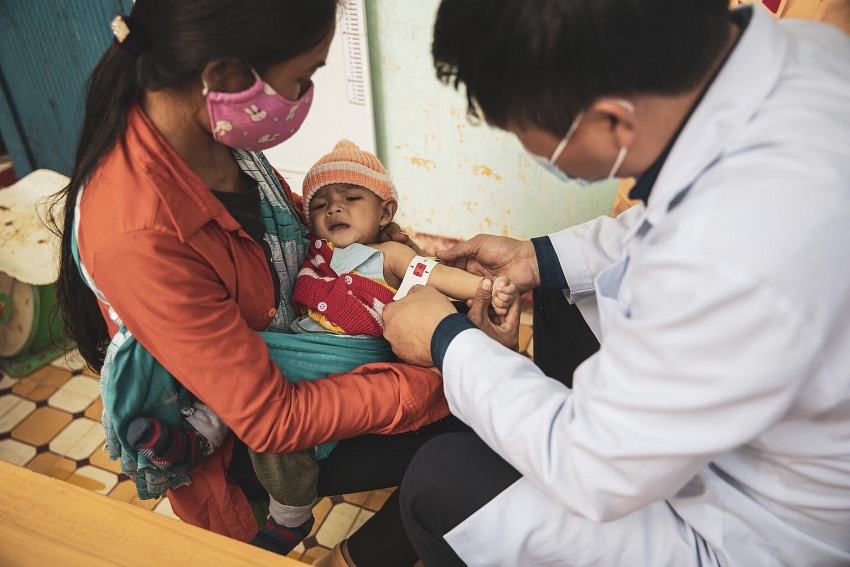Acceleration urged for treatment of child malnutrition
 |
UNICEF continues to gather global evidence on the rising levels of malnutrition among children. All forms of this disease are prevalent in Vietnam, where the estimate based on the 2019 annual nutrition surveillance revealed that 230,000 children under the age of five suffer from severe acute malnutrition (SAM) annually.
Malnutrition is listed as a disease in the World Health Organisation's (WHO) International Classification of Diseases, and it is preventable and treatable. Wasting, defined as low weight-for-height, is the most visible and lethal type of malnutrition. Severe wasting – when children are too thin for their height resulting in weakened immune systems – is the most immediate, visible, and life-threatening form of the disease.
Worldwide, at least 13.6 million children under five suffer from severe wasting, resulting in one in every five deaths among this age group.
Given the close links between SAM, growth stunting, and mortality, interventions aimed at the prevention and treatment of SAM will have far-reaching benefits. The country has prioritised policies through resolutions and subsequent directives emphasising the enhancement of nutritional care. Prevention and the treatment of children with SAM are two of the key objectives of the National Nutrition Strategy 2021-2030.
“Vietnam has established a positive environment for SAM prevention and treatment, with clear political commitments”, said UNICEF representative, Rana Flowers.
“However, there are no policies or funding sources identified in central or local budgets for the integrated management of acute malnutrition, with 90 per cent of SAM cases being untreated. Now is the time to accelerate ongoing efforts by taking action to include examinations and treatment of SAM children in the revision of the Law on Medical Examination and Treatment”, she added.
The nationwide expansion of this intervention requires a funding mechanism for management and treatment. To reach every child with life-saving treatments, UNICEF is calling for countries to include treatments within health insurance and long-term development funding schemes so that all children can benefit.
Given that SAM can only be treated effectively by using specialised nutritional products that need to be prescribed under medical guidance, a specific legal framework to enable access is required. Amendments of the various laws related to health which are being reviewed currently offer a unique opportunity to address the poor access to treatment.
“By incorporating the use of therapeutic nutritional products for the treatment of children with SAM into the amendment of laws that are being reviewed now, Vietnam will pave the way to save the lives of an estimated 230,000 children every year”, Flowers said.
“Otherwise, these children face the risk of dying from a disease that can be easily prevented and treated. Vietnam has the resources and capacity to prevent these unnecessary deaths by ensuring that children with SAM have the health care and treatment they need to survive, thrive, and develop to their full potential.”
What the stars mean:
★ Poor ★ ★ Promising ★★★ Good ★★★★ Very good ★★★★★ Exceptional
Themes: Healthcare Platform
- Takeda Vietnam awarded for ongoing support of Vietnam’s sustainability efforts
- Self-care signals shift towards sustainable healthcare
- DKSH to acquire Vietnamese healthcare distributor Biomedic
- Two national hospitals expand capacity with new facilities
- Vietnam moves to enhance disease prevention, equity, and sustainability
Related Contents
Latest News
More News
- Vietnam moves to enhance disease prevention, equity, and sustainability (December 18, 2025 | 17:39)
- New ILO report offers policy recommendations for disability inclusion (December 04, 2025 | 15:18)
- Maternal job loss may affect children’s mental health, research shows (December 03, 2025 | 19:11)
- Women lead Vietnam’s shift to climate-resilient agriculture (December 03, 2025 | 19:10)
- Experts highlight unpaid care work as key barrier to gender equality (December 03, 2025 | 15:15)
- Opportunities and inequalities for women workers in Vietnam's garment industry (December 03, 2025 | 09:00)
- Vietjet flights carry love to devastated central region (November 28, 2025 | 11:35)
- New initiative to boost the fight against domestic violence (November 26, 2025 | 10:00)
- South Korea funds IOM relief for Vietnam’s typhoon-affected communities (November 24, 2025 | 15:33)
- AI and human-centred values set to shape the future of HR in Vietnam (November 21, 2025 | 18:04)

 Tag:
Tag:

























 Mobile Version
Mobile Version